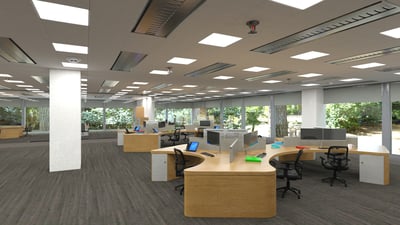 No two lighting projects are exactly alike. When you’re helping a client upgrade to LED, at some point in the process, you’ll have to evaluate whether to install new lighting fixtures or take advantage of a new era of LED retrofits. But deciding which way to proceed is not always as straightforward as it might sound.
No two lighting projects are exactly alike. When you’re helping a client upgrade to LED, at some point in the process, you’ll have to evaluate whether to install new lighting fixtures or take advantage of a new era of LED retrofits. But deciding which way to proceed is not always as straightforward as it might sound.
Factors like overall project goals, budget, performance, and aesthetic considerations all play a role. In each case, there are advantages (and disadvantages) to choosing fixtures or retrofits. Here are some tips to help you decide which option is right for your project.
Define the Problem Your LED Lighting Project Is Helping to Solve
There’s no such thing as “wrong” lighting. Whether it’s a new fixture or retrofit, lighting that might not work for one application could be just the thing for another. When trying to decide what you need, the first thing to do is make sure you’ve clearly defined the problem so that you can identify how your project will solve it. Asking the right questions will help.
What’s the expense over the life of the product?
 Not every project will be about price (more on that in a minute). But for those projects where you want to maximize your return on investment, it’s important to make sure you look beyond the cost of the product and consider the expense over the life of the product.
Not every project will be about price (more on that in a minute). But for those projects where you want to maximize your return on investment, it’s important to make sure you look beyond the cost of the product and consider the expense over the life of the product.
While Litetronics offers retrofits that offer the same lifespan as new fixtures, not every company does. That means some retrofits will cost less up front but will need to be replaced sooner. Rebates and incentives are another factor that can help dramatically change the equation. When you’re calculating the difference in expense between a new fixture and a retrofit, make sure you’ve accounted for all these variables.
Are you trying to match the appearance of other existing light fixtures?
For some projects, the biggest concern is creating a unified, cohesive look. A corporate campus, for instance, may be adding new construction beside much older buildings but still want a consistent appearance throughout them all.
For this type of lighting project, you may find a combination of fixtures and retrofits are both necessary. You might install new fixtures in the new building but choose retrofits that match in appearance for the older building on campus. If that sounds like a nightmare of comparison shopping trying to find products that match, talk to Litetronics. We offer several products with both retrofit and new fixture options.
Will the building infrastructure support the kind of lighting you want to put in?
Another variable to consider is the building itself. Depending on the condition it’s in, it may not easily accommodate the installation of new fixtures. It could be something as simple as the type of housing that’s already installed. Or it could be something a little more complicated, such as a ceiling full of asbestos that would have to be properly removed before a new fixture could be installed.
Updating infrastructure likely goes beyond the scope of your work. It can also add quite a bit of expense to the job. In cases like those, a retrofit is likely to be a much better choice.
Are there any code, electrical, or facility limitations that will need to be factored into your decision?
We’ve already touched on infrastructure, but there are many potential tripwires when it comes to building codes, electrical issues, or facility limitations that may favor retrofits over new fixtures. Depending on who your customer is, some facilities have special policies and procedures that can add significant time and expense to new installations.
It’s considerations like these that bring us to our next point.
Don’t Underestimate the Labor Difference Between New Fixtures and Retrofits
 If you’ve ever completed a lighting project in a hospital or health care facility, you know how careful they are to protect the health and safety of their patients. Hospitals especially will typically have requirements for visiting contractors to ensure that infectious material won’t be introduced into the environment.
If you’ve ever completed a lighting project in a hospital or health care facility, you know how careful they are to protect the health and safety of their patients. Hospitals especially will typically have requirements for visiting contractors to ensure that infectious material won’t be introduced into the environment.
This can make certain lighting projects get very complicated, very quickly. If you’re trying to install a new fixture, for instance, you need to consider the cost of using a sealed cart with all debris and bacteria removed, along with the special procedures for removing and disposing of the old fixture safely. These factors can quickly add up to make new fixtures a lot more expensive (and difficult) to install than a retrofit.
While this might seem like an extreme example, it’s far from the only factor that can drive up the expense of installing new fixtures.
Disposal Costs and Other Expenses Can Add Up Quickly When You’re Installing New Fixtures
One of the most common ways contractors underestimate the scope of their lighting projects is when it comes to disposal costs. Unlike a retrofit, where you’re only removing an old lamp and replacing it with a new LED, new fixtures require you to fully disconnect and remove the old hardware.
In some environments, like an office building or a school, that can mean getting up into ceiling tiles, clearing a path, removing the old metal housing, installing the new panel, putting the tiles back into place, and cleaning the (now very dusty) work area. All these little steps can quickly add up to a lot more time, especially if you’re replacing multiple fixtures.
Then there’s the question of what to do with all those old lighting fixtures. Do you pay to bring in a dumpster? Do you haul the old fixtures away yourself to dispose of somewhere off-site? One way or another, disposing of all that material is going to add even more time and expense to the job.
Granted, this may not be your first rodeo — you may have gone through this process before and found a disposal option that works for you. But if retrofits save you and your customer time and money and work just as well for the project, maybe new fixtures aren’t the solution you need.
Get Guidance on New Fixtures and Retrofits From an Experienced Design Team
Whether you’ve been in this industry for decades or you’re new to the business, it always helps to have someone else in your corner. When it comes to deciding whether new fixtures or retrofits are right for your project, the Litetronics team is here to help.
Our sales and design teams can answer your questions, provide detailed product information, and share tried-and-true best practices learned in the field. Our partnerships with reputable distributors and local agents mean we can also connect you with reliable help when you need it.
Ready to get started? Contact us today.

